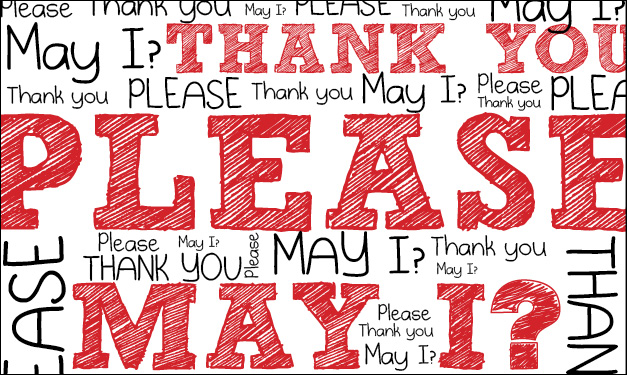Manners count. They really do. Check out these resources (for perfectly polite kids).
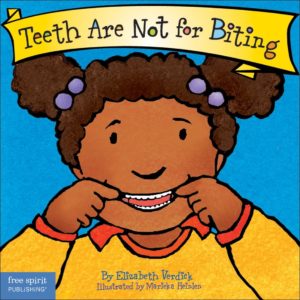
|
Elizabeth Verdick’s Best Behavior series (Free Spirit Publishing) gets right to the point with such titles as Teeth Are Not for Biting, Hands Are Not for Hitting, and Words Are Not for Hurting. For ages 2-3. |
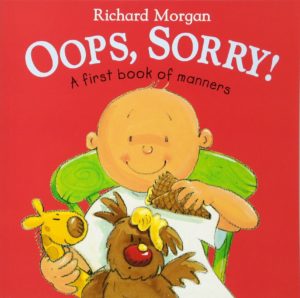
|
Richard Morgan’s Oops, Sorry (Barron’s Educational Series, 2005) is written in the form of a helpful quiz. “If someone gives you something nice, what do you say?” Turn the page to find out. (“Thank you!”) For ages 2-5. |
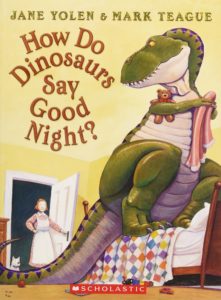 |
In Jane Yolen’s clever rhyming How Do Dinosaurs Say Good Night? (Blue Sky Press, 2000), dinosaurs model proper going-to-bed behavior. “Does a dinosaur slam his tail and pout?/Does he throw his teddy bear all about?” (No. No, he/she doesn’t.) For ages 2-7. |
| There are many well-behaved dinosaur sequels, among them How Do Dinosaurs Play with Their Friends?, How Do Dinosaurs Eat Their Food?, and How Do Dinosaurs Clean Their Room? | |
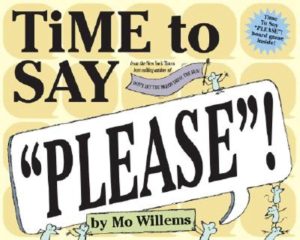
|
In Mo Willems’s Time to Say “Please” (Disney-Hyperion, 2005), a gang of mice – armed with colorful word bubbles – deal with the basics of please, thank you, excuse me, and I’m sorry. For ages 3-6. |
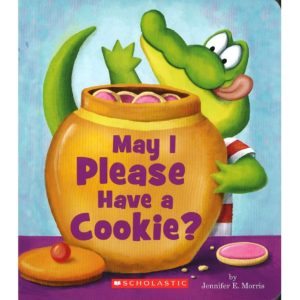
|
In Jennifer Morris’s May I Please Have a Cookie? (Cartwheel Books, 2005), Alfie, a little alligator, tries everything he can think of to get a cookie – grabbing, disguises, tears – before finally realizing that he only needs to say “please.” For ages 3-6. |
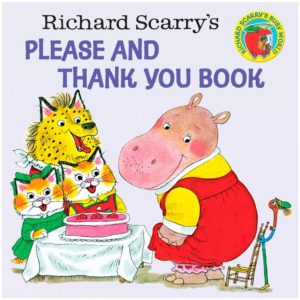
|
In Richard Scarry’s Please and Thank You Book (Random House, 1973), short stories starring the familiar Scarry characters – cats, pigs, and hippos, and, of course, Lowly Worm – demonstrate good and bad behavior. For ages 3-7. |
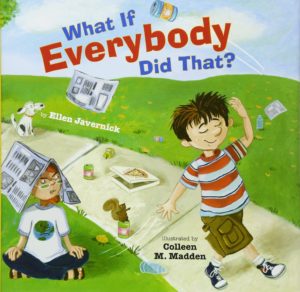
|
Ellen Javernick’s picture book What If Everybody Did That? (Two Lions, 2010) shows the consequences of breaking rules as a boy feeds the bears at the zoo, races with a supermarket cart, interrupts at storytime, and tosses a soda can out the car window – each time to be confronted with a cross adult saying “What if everybody did that?” On the next page, there’s a picture of the awful consequences. For ages 3-7. |
| Also see Javernick’s What If Everybody Said That? (Two Lions, 2018), which covers what happens if everybody said “No boys allowed!” or “Me first!” | |
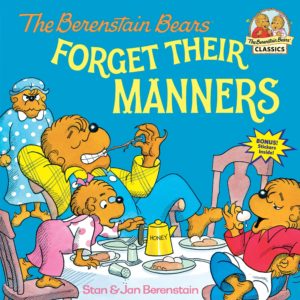
|
In Stan and Jan Berenstain’s The Berenstain Bears Forget their Manners (Random House, 1985), rudeness has gotten out of hand as Brother and Sister Bear push, shove, grab for food, call names, and kick each other under the table. Mama Bear comes up with a helpful Politeness Plan. For ages 3-7. |
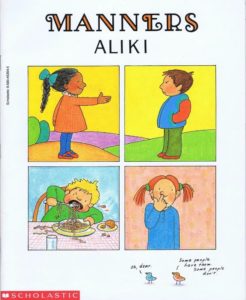 |
Aliki’s charmingly illustrated Manners (Greenwillow Books, 2007) explains good and bad manners through clever panel cartoons and speech bubbles, with some side comments from a trio of little birds. For ages 3-8. |
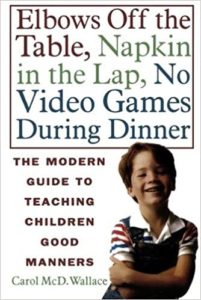 |
By Carol Wallace, Elbows off the Table, Napkin in the Lap, No Video Games During Dinner (St. Martin’s Griffin, 1996) is touted as a modern guide to teaching kids manners. Many suggestions for parents of kids ages 3-12. |
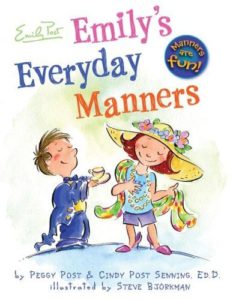
|
By Cindy Post Senning and Peggy Post, Emily’s Everyday Manners (HarperCollins, 2006) features best friends Emily and Ethan who ride the bus, go to the playground, visit friends, and go out to dinner, all with exemplary manners. For ages 4-7. |
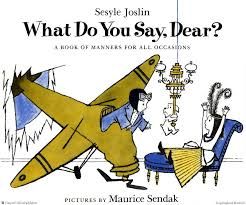
|
Sesyle Joslin’s wonderful What Do You Say, Dear? (HarperCollins, 1986) – with illustrations by Maurice Sendak – is filled with zany hypothetical situations, to each of which is appended the question “What do you say, dear?” What to say if you inadvertently bump into a crocodile? Or if you’re introduced to a baby elephant? For ages 4-8. |
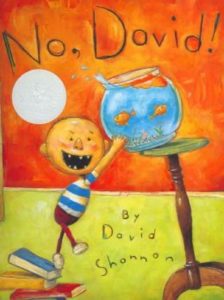 |
David Shannon’s No, David! (Blue Sky Press, 1998) is an object lesson in what not to do, as irrepressible David goes from bad to worse. (But is still loved anyway.) For ages 4-8. |
 |
Karla Kuskin’s wonderful etiquette poem Rules appears in The Random House Book of Poetry for Children (Random House, 1983). (“Do not jump on ancient uncles/Do not yell at average mice/Do not wear a broom to breakfast/Do not ask a snake’s advice.”) |
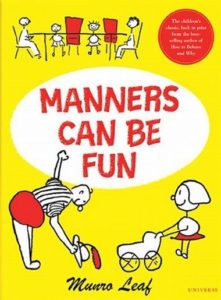
|
Munro Leaf’s Manners Can Be Fun (Universe, 2004) – illustrated with goofy little stick figures – begins “Having good manners is really just living with other people pleasantly. If you lived all by yourself out on a desert island, others would not care whether you had good manners or not.” But, since most of us don’t live on desert islands, the author – with the help of some bad behavers – covers polite ways of meeting people, table and conversation etiquette, treating people and objects with respect (don’t act like Smash, Rip, or Ruin), and taking responsibility for yourself. For ages 4-8. |
| In the same format, also by Leaf, see How to Behave and Why and How to Speak Politely and Why. | |
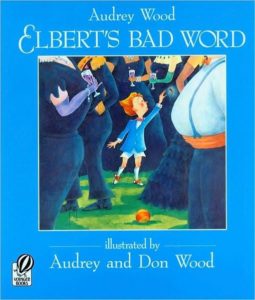
|
By Audrey Wood, Elbert’s Bad Word (Houghton Mifflin Harcourt, 1996) is the witty and hilarious story of Elbert who, whacked with a croquet ball on his great toe at a garden party, lets loose (to the horror of all) a very bad word. The word – a little rat-like creature – persists in following Elbert around until finally the wizard-like estate gardener comes up with a magic spell that replaces Elbert’s bad word with a lot of sparkling creative alternatives. (RATS AND BLUE BLAZES!) For ages 4-8. |
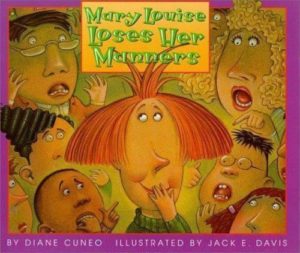
|
In Diane Cuneo’s Mary Louise Loses Her Manners (Yearling, 2000), poor Mary Louise has simply lost her manners, with awful consequences. So off she goes to try to get them back. For ages 4-8. |
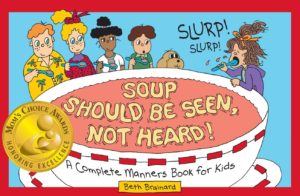
|
Beth Brainard’s Soup Should be Seen, Not Heard (Good Idea Kids, 2012) – with cartoon illustrations and cute chapter titles (“Dear Grammy,” “You Can’t Wear Your Sweats to Sunday School”) – covers greetings, telephone etiquette, table manners, messages, personal grooming, and party manners. For ages 5-8. |
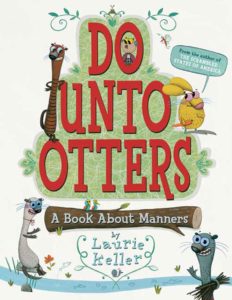
|
In Laurie Keller’s Do Unto Otters (Square Fish, 2009), Mr. Rabbit’s new neighbors are otters and he has no idea how to treat them. What if they don’t get along? Helpful Owl suggests he follow the Golden Rule: treat the otters like you’d like them to treat you. For ages 5-8. |
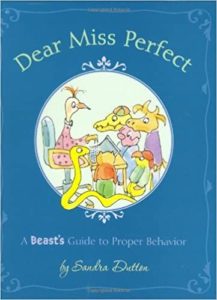
|
Sandra Dutton’s Dear Miss Perfect: A Beast’s Guide to Proper Behavior (Houghton Mifflin Harcourt, 2007) is a tongue-in-cheek guide to manners through the problems of young animals, all described in letters. “Dear Miss Perfect,” fourth-grader Emily Possum writes. “My problem is that I like to hang upside down. Mama lets me do it at home. That’s how I’m most comfortable and the way I learn.” But Emily teacher says NO. How to cope? For ages 6-9. |
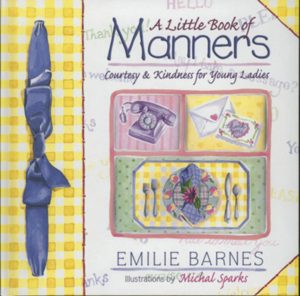
|
By Emilie Barnes, A Little Book of Manners: Courtesy & Kindness for Young Ladies (Harvest House Publishing, 1998) – through the eyes of young Emilie Marie – covers such topics as thank-you notes, dinner-table etiquette, party and telephone manners, and more. For ages 6-10. |
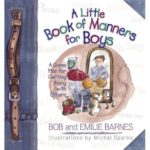 |
By Bob and Emilie Barnes, also see A Little Book of Manners for Boys (Harvest House Publishers, 2000). |
 |
Roald Dahl’s Charlie and the Chocolate Factory (Puffin, 2007) is – I would argue – a book about the triumph of manners, as kind and honest Charlie Bucket is put up against such obnoxious contestants as greedy Augustus Gloop, spoiled Veruca Salt, and aggressive Mike Teavee. For ages 7-12. |
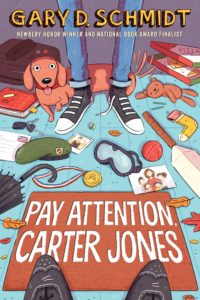 |
In Gary Schmidt’s Pay Attention, Carter Jones (Clarion, 2019), Carter’s fraught family inherits a very proper British butler. For ages 8-13. |
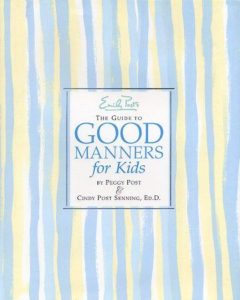
|
By Cindy Post Senning and Peggy Post, Emily Post’s Guide to Good Manners for Kids (HarperCollins, 2004) is what Emily Post would have said if Emily Post were still around. The book is divided into seven sections, covering Everyday Life, At Home, At School, At Play, Out and About, On the Go – Away From Home, and Special Occasions. For ages 8-13. |
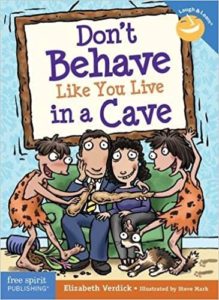
|
Elizabeth Verdick’s 128-page humorous Don’t Behave Like You Live in a Cave (Free Spirit Publishing, 2010) – in which cartoon-style Cave Boy and Cave Girl display thoroughly bad manners throughout the book – makes a good case for the advantages of good behavior. For ages 9-12. |
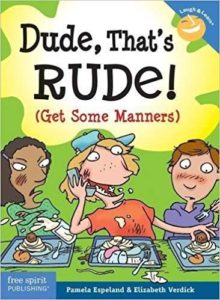 |
By Pamela Espeland and Elizabeth Verdick, Dude, That’s Rude (Free Spirit Publishing, 2007) – illustrated with Simpson-like cartoon characters – is a catchy guide to etiquette using lots of real-world scenarios and a sense of humor. For ages 9-13. |
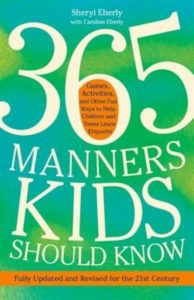
|
Sheryl Eberly’s 365 Manners Kids Should Know (Harmony, 2011) has an etiquette instruction for every day of the year, covering everything from proper jewelry and when to wear a hat to texting, television, thank-you letters, and swimming pool behavior. Included are “games and activities” to help kids learn etiquette. The author suggests a lot of parental quizzing. |
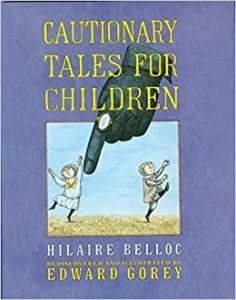
|
Hilaire Belloc’s Cautionary Tales for Children (Houghton Mifflin Harcourt, 2002) – in this edition, with great illustrations by Edward Gorey – was originally published in 1907. It’s a spoof on 19th century moral tales and consists of ten tales (in verse) about the awful consequences of bad behavior. Titles include “Jim, Who ran away from his Nurse, and was eaten by a Lion” and “Rebecca Who Slammed Doors for Fun and Perished Miserably.” The eleventh tale and final tale is “Charles Augustus Fortescue, Who Always Did what was Right, and so Accumulated an Immense Fortune.” For ages 12 and up and all with a wicked sense of humor. |
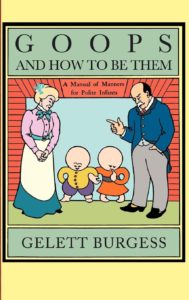 |
By Gelett Burgess – author of the immortal poem “I Never Saw a Purple Cow” – Goops and How to Be Them (Applewood Books, 2005), originally published in 1928, is an upside-down guide to manners by way of the perfectly awful Goops. (Don’t be one!) A fun read for all ages. |
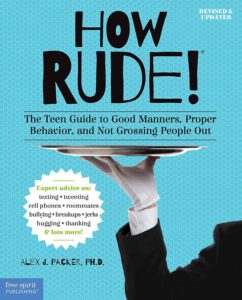
|
Alex J. Packer’s How Rude! (Free Spirit Publishing, 2014) is a tome – over 500 pages long – but packed with helpful and polite advice on everything from texting and tweeting to bullying, breakups, and jerks. Includes lots of “Dear Alex” etiquette questions. For ages 13 and up. |
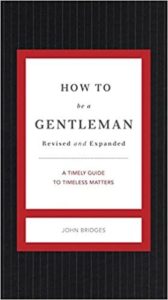 |
John Bridges’s elegant How To Be a Gentleman (Thomas Nelson, 2012) – which opens with the “10 Eternal Truths of the Gentlemanly Life” – has ten helpful chapters, variously titled “A Gentleman Gets Dressed,” “A Gentleman Goes to Dinner,” and “A Gentleman Goes to a Party.” For teens and adults. |
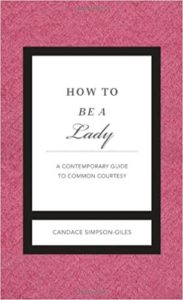 |
For those of the opposite sex, check out Candace Simpson-Giles’s How to Be a Lady (Thomas Nelson, 2012). (“A lady does not use her camera phone in ways that intrude upon the privacy of others.”) For teens and adults. |
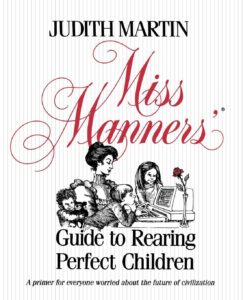
|
Judith Martin’s Miss Manners’ Guide to Rearing Perfect Children (Touchstone, 2002) is perfectly delightful (as are all the Miss Manners etiquette books). Sections have introductions with basic information, followed by many begging-for-advice letters, each with a terrific response from Miss Manners. An addictive read for adults. |
| Check out George Washington’s Rules of Civility. (“In the Presence of Others, Sing not to yourself with a humming Noise, nor Drum with your Fingers or Feet.”) | |
 |
Lord Chesterfield’s Letters (Oxford University Press, 2008) to his son, Philip, are a fascinating window on life, society, politics, and etiquette for the 18th-century young man. For older teenagers and adults. |
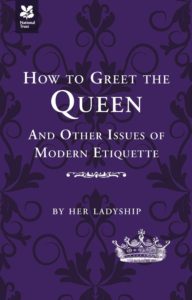 |
Caroline Taggart’s How to Greet the Queen (National Trust, 2014) is a catchy compendium of manners for interacting with royalty. For older teenagers, adults, and royal groupies. |
| From Emily Post, see this list of Top Table Manners for Kids. | |

|
Need help with setting the table? The Tot Talk Table Setting & Etiquette Placemat shows just where to put silverware, plates, glasses, and napkin. |
